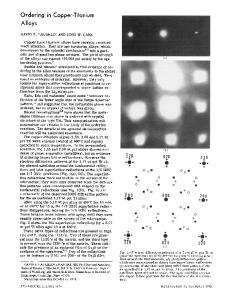Grain-refinement mechanisms in titanium alloys
- PDF / 1,115,059 Bytes
- 8 Pages / 585 x 783 pts Page_size
- 15 Downloads / 366 Views
Despite the importance of the prior- grain structure in determining the properties of titanium-based alloys, there are few published studies on methods of controlling the size of these grains in commercial alloys. The existing research raises questions about the relative importance of solute elements in grain-refining mechanisms, particularly the common alloying elements of aluminum and vanadium. The effect of these elements was investigated by producing a series of castings in a nonconsumable arc-melting furnace, and the results were interpreted with the aid of available phase-diagram information and solute-based models of grain refinement. A small reduction in grain size was obtained with increasing solute additions; however, this was not expected from the theoretical analysis. Possible reasons for this discrepancy are discussed.
I. INTRODUCTION
The demand for titanium and its alloys has experienced rapid growth in recent years, and growth is expected to continue in the future.1,2 Historically, the aerospace industry has dominated the titanium market; however, titanium use is spreading to other markets such as industrial/chemical processing and consumer goods.3 Due to the relatively high cost of titanium, near-netshape processing routes such as casting are particularly attractive. Like other cast metals, the in-service and processing properties of titanium castings are very dependent on the microstructure, including the degree of refinement of the microstructure. The high-temperature liquid–solid transformation in most commercial titanium alloys involves the nucleation and growth of -grains. Despite subsequent solid-state -to-␣-transformations, the size and location of prior- grains is believed to be important for a variety of mechanical properties including strength, ductility, and fatigue resistance.4 Furthermore, -grain boundaries may be important in determining fracture toughness through arresting crack growth,5 and a refinement of prior- grains has been shown to optimize the corrosion fatigue resistance of Ti–6Al–4V surgical implants.6 The corrosion resistance of commercially pure Ti in acidic solutions is also reported to improve with grain refinement,7 as is the ability of titanium implants to osteointegrate8; however, in these cases the authors have not specified whether they refer to - or ␣-grains. Other work9 has a)
Address all correspondence to this author. e-mail: [email protected] DOI: 10.1557/JMR.2008.0002 J. Mater. Res., Vol. 23, No. 1, Jan 2008
http://journals.cambridge.org
Downloaded: 13 Mar 2015
suggested that grain refinement lowers the superplastic forming temperature of Ti–6Al–4V, which consequently has a number of manufacturing benefits including extended die life. In contrast to this, a large coarse -grain size in Ti–6Al–4V can be beneficial during superplastic forming operations, in particular by reducing oxygen absorption,10 while others11 have suggested there is no benefit from refining -grains in terms of hot workability. Despite the significance of the prior- grain
Data Loading...










